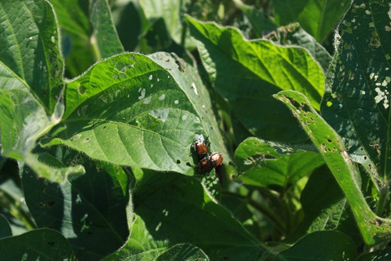Japanese beetles overwinter as grubs in the soil, pupate in spring, and emerge as adults in June and July. Once it’s July, Japanese beetles start laying eggs, which continues into August. But whether larvae or adults, Japanese beetles are problematic at both stages. Beetles feed on the leaves of corn, soybeans and a wide variety of other plants. They can cause extreme defoliation; and if your crops are under stress, their feeding may cause yield loss.

Japanese beetle life cycle and identification
Japanese beetles complete one life cycle each year. They overwinter in the soil; and as soil temperatures warm, larvae move closer to the surface and pupate. Adults begin to emerge in mid-June, and females lay eggs in July and August. As eggs hatch in the soil, larvae feed on roots and decaying plant material.

Japanese beetle larvae can be identified by the following:
- About ½ to 1 inch long
- Cream-colored with a brown head; can be confused with other common soil grubs
Adult Japanese beetles can be identified by the following:
- About ½ inch long
- Shiny metallic green head with bronze wings
- White tufts of hair on each side of abdomen

Injury to soybean fields
Japanese beetles feed on more than 300 plants, including field crops and ornamental plants. Japanese beetles feed on leaf tissue between the veins, resulting in a distinctly “skeletonized” look, with leaf veins remaining and the leaf tissue removed. By chewing on the tissue between soybean leaf veins, this insect can reduce yields and leave soybean fields full of lacey leaves. When Japanese beetles continue feeding on soybean leaves, they remove more leaf tissue and reduce the leaf surface area needed for photosynthesis, potentially leading to reduced grain fill and lower yields.
Japanese beetle scouting tips
Japanese beetles provide the greatest risk of injury during crop reproductive stages. Japanese beetles will primarily feed on the upper leaves, so check the top leaves for their presence or look for a cut-out leaf appearance. While damage will primarily be on the upper leaves, evaluate the entire canopy for defoliation to determine the extent of the damage.
Scouting entire fields for signs of Japanese beetle damage will give you a better view of just how much pressure is present. Japanese beetles tend to gather in sections of fields, so if only portions of fields are scouted, this may give the appearance that infestation levels are higher than they actually are. The University of Minnesota recommends taking defoliation counts from 10 or more plants throughout the entire field, versus limiting yourself to just one area. Determine the average across 3 leaves and then across multiple plants. Use this table to estimate percent defoliation for each leaf of the plant and identify treatment thresholds based on growing stage. 20% defoliation typically warrants treatment.
The mobility of these pests makes managing them difficult and scouting soybeans fields frequently essential. Because of how mobile Japanese beetles are, feeding damage is generally higher along the borders, as they move into the field from other host plants.
Japanese beetles have several look-alikes, including the false Japanese beetle or sand chafer, so be careful when scouting. While false Japanese beetle adults are about the same size as Japanese beetles, they don’t have a metallic green head. Another difference is that false Japanese beetles may range from coppery brown to black. And although false Japanese beetles may have some white hairs along the abdomen, they aren’t organized into tufts.
Japanese beetle treatment thresholds
Management of this pest can be tricky. Japanese beetles feed on such a wide variety of plants that they can be tough to control. To prevent yield loss in soybeans, consider an insecticide treatment if defoliation is 30% or greater during vegetation and more than 20% during the reproductive stages. If your soybean fields hit these thresholds, apply an insecticide like Endigo® ZC, which combines 3 industry-leading technologies for quick knockdown and extended residual control.
Keep in mind that because of their mobility, Japanese beetles may repopulate an area that was recently treated. If that’s the case, retreatment may be necessary to protect leaf tissue during pod fill. Be sure to continue scouting after initial application, as you may need another treatment if the pest persists.
Contact your Golden Harvest Seed Advisor with questions or for additional agronomic insights.
Photos are either the property of Syngenta or used under agreement.
Syngenta hereby disclaims liability for third-party websites.
Product performance assumes disease presence.
© 2022 Syngenta. Important: Always read and follow label instructions. Some products may not be registered for sale or use in all states or counties. Please check with your local extension service to ensure registration status. Endigo ZC and Endigo ZCX are Restricted Use Pesticides.
Some seed treatment offers are separately registered products applied to the seed as a combined slurry. Always read individual product labels and treater instructions before combining and applying component products. Orondis Gold may be sold as a formulated premix or as a combination of separately registered products: Orondis Gold 200 and Orondis Gold B.
The trademarks or service marks displayed or otherwise used herein are the property of a Syngenta Group Company. All other trademarks are the property of their respective owners.